Messina ([mesˈsiːna], Sicilian: Missina, Greek: Μεσσήνη/Μεσσήνα) is a port in the northeast corner of Sicily. Most visitors are passing through, on the 5-km ferry-crossing to mainland Italy. Although it dates to ancient times, Messina is modern and nondescript. Older buildings were mostly destroyed by the great earthquake and tsunami of 28 Dec 1908, then Allied bombing in World War II finished what was left. Nevertheless it has enough sights to justify spending a day. One modern claim to fame is that in June 1955, Messina hosted the conference that set up the European Community and common market, later the European Union.
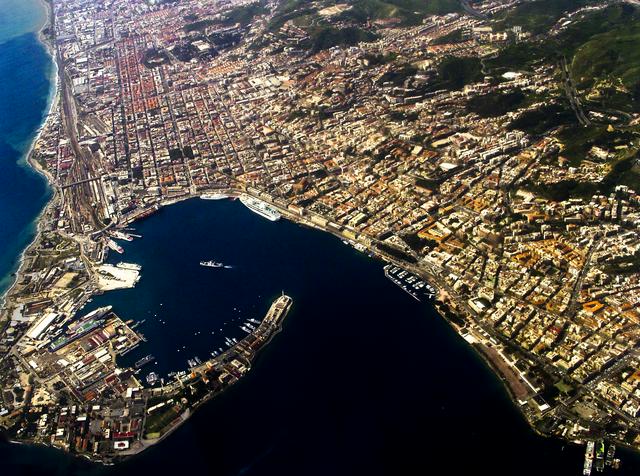
The Tourist Information Centre is just outside the railway station. Open M-F 09:00-13:00 and 15:00-17:00 (M W to 18:30).
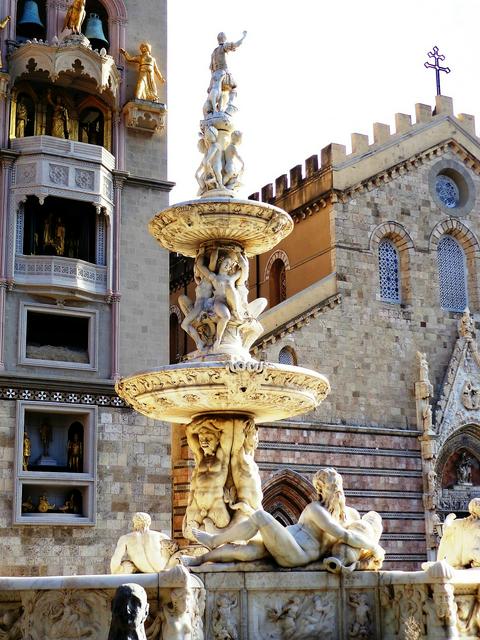
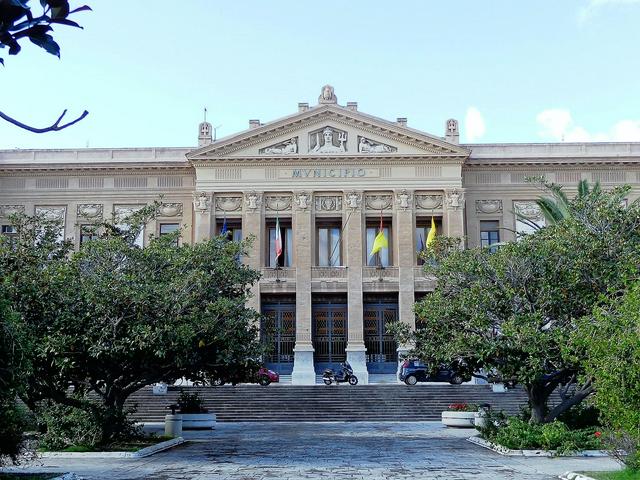
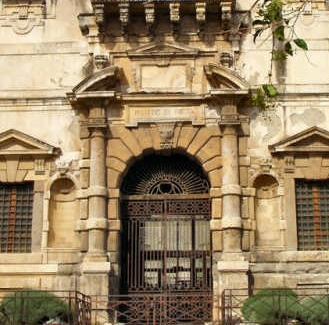
There is not too much of historical architecture remains in the city due to earthquakes (esp. in 1908) and World War II bombing. Still there are enough things to see there to make a good walk. Places around the Sanctuary of the Madonna of Montalto and Cristo Re offer beautiful panoramic views over the harbour and the Strait of Messina (see the banner).
- Madonna della Lettera. The Madonna of the Letter is venerated by the Catholic Church as a saint patron of Messina. A towering gilded statue of the Madonna della Lettera is located atop of the tall Forte San Salvatore tower at the tip of the sickle in the sickle-shaped harbour. The inscription "We bless you and your City" is taken from a letter from Mary in 42 AD.
- Duomo di Messina, Piazza del Duomo. A Gothic cathedral which dates to the 12th century. The cathedral suffered serious damage in the 1908 earthquake and was restored between 1919 and 1920. During the Second World War, Allied bombings destroyed part of the Cathedral, which was rebuilt in 1943. It is consecrated to the “ Virgin of the Letter”, The Patronnes of the Town.
* Campanile del duomo di Messina, Piazza del Duomo (next to the Duomo. The Duomo's bell tower has one of the largest astronomical clocks in the world, built in 1933 by the Ungerer Company of Strasbourg. A must-see for visitors with an amazing clock show, including symbolical and allegorical moving metal animals and statues, every day at 12:00.
* Fontana di Orione, Piazza del Duomo (next to the Duomo. Work of Montorsoli (1547), a student of Michelangelo. Orion, with his dog Sirius, is portrayed as one of the legendary founders of Messina.
- Palazzo Calapaj-d'Alcontres. An 18th-century building, perhaps of a relatively modest exterior, but it's one of a few ones survived the earthquake of 1908.
- Palazzo Zanca, Piazza Unione Europea. Municipio of Messina was built in 1924 in Neoclassical style under direction by Antonio Zanca.
* Fontana Senatoria.
- Museo regionale di Messina, Viale della Libertà 465 (tram terminus "Museo", +39 09 036 1292. Tu-Sa 09:00-19:00, Su 09:00-13:00. Collections of medieval art and modern works. Note especially the altarpiece of San Gregorio by Antonello da Messina,and the Resurrezione di Lazzaro (Raising of Lazarus) and Adorazione dei pastori (Adoration of the Shepherds) both by Caravaggio. €8.
- Chiesa dei Catalani. One of a few survivors of the earthquake in 1908. Its origin dates to the 12th century in later Norman style with Arabic-influenced elements.
- Quattro Fontane. Two smaller fountains survived out of four built between 1666 and 1742.
- ex Chiesa di Santa Maria Alemanna. This former church built early 13th century is a rare example of a Gothic style in the city. The church was badly damaged in 1908 and was open back to the public in 2001. It hosts various exhibitions.
- Chiesa del Carmine. A church with 7 chapels decorated inside with polychrome marble. It also known for its Tamburini Organ renown for its complex rich sounds (installed in 1950s).
- Galleria Vittorio Emanuele III. An eclectic building constructed between 1924 and 1929 in Liberty style. Inside it consists of 3 passages converging into a hexagonal centre covered by a glass dome. It's somewhat similar to other galleria's across Italy.
- Palazzo del Monte di Pietà. The current building is essentially a ground floor of the former palazzo which was severely damaged by earthquakes and World War II bombing.
- Santuario della Madonna di Montalto. Sanctuary is a building made in an eclectic style with Gothic and Romanesque elements, located high above the Piazza del Duomo. From its lookout point, with a statue of the Pope admiring the view, you can enjoy a panorama of the Messina harbour and the Strait of Messina.
- Fontana Falconieri, Piazza Basicò.
- Sacrario di Cristo Re. Built at the remains of the medieval castle of Matagrifone, Christ the King is a majestic domed memorial chapel, located on a hilltop north of the Sanctuary of the Madonna of Montalto. also with a beautiful panoramic view of the harbour and strait. Built in 1937, it serves as a burial chamber in honour of some fellow citizens who died in Africa as soldiers in the Second World War.
- Chiesa di Montevergine. The church hosts remains of the Catholic saint Eustochia Smeralda Calafato.
- Fontana del Nettuno, Via G. Garibaldi. Another monumental fountain by Montorsoli featuring Neptune accompanied with Scylla and Charybdis.
- Porta Grazia di Messina, Piazza Casa Pia. The former main gate of the Messina's citadel. These days it stays at the Piazza Casa Pia dei Poveri. A few other surviving parts of the citadel still can be seen at the original location of the citadel at the SE corner of the port albeit in a pretty neglected state.
- Villa de Pasquale, Via Marco Polo 266 (Contesse district, +39 0903674611. A beautiful Neo-Renaissance villa in Liberty style built in 1912 and restored in 2016.
Madonna della Lettera. The Madonna of the Letter is venerated by the Catholic Church as a saint patron of Messina. A towering gilded statue of the Madonna della Lettera is located atop of the tall Forte San Salvatore tower at the tip of the sickle in the sickle-shaped harbour. The inscription "We bless you and your City" is taken from a letter from Mary in 42 AD.
Duomo di Messina, Piazza del Duomo. A Gothic cathedral which dates to the 12th century. The cathedral suffered serious damage in the 1908 earthquake and was restored between 1919 and 1920. During the Second World War, Allied bombings destroyed part of the Cathedral, which was rebuilt in 1943. It is consecrated to the “ Virgin of the Letter”, The Patronnes of the Town.
* Campanile del duomo di Messina, Piazza del Duomo (next to the Duomo. The Duomo's bell tower has one of the largest astronomical clocks in the world, built in 1933 by the Ungerer Company of Strasbourg. A must-see for visitors with an amazing clock show, including symbolical and allegorical moving metal animals and statues, every day at 12:00.
* Fontana di Orione, Piazza del Duomo (next to the Duomo. Work of Montorsoli (1547), a student of Michelangelo. Orion, with his dog Sirius, is portrayed as one of the legendary founders of Messina.
Palazzo Calapaj-d'Alcontres. An 18th-century building, perhaps of a relatively modest exterior, but it's one of a few ones survived the earthquake of 1908.
Palazzo Zanca, Piazza Unione Europea. Municipio of Messina was built in 1924 in Neoclassical style under direction by Antonio Zanca.
* Fontana Senatoria.
Museo regionale di Messina, Viale della Libertà 465 (tram terminus "Museo", +39 09 036 1292. Tu-Sa 09:00-19:00, Su 09:00-13:00. Collections of medieval art and modern works. Note especially the altarpiece of San Gregorio by Antonello da Messina,and the Resurrezione di Lazzaro (Raising of Lazarus) and Adorazione dei pastori (Adoration of the Shepherds) both by Caravaggio. €8.
Chiesa dei Catalani. One of a few survivors of the earthquake in 1908. Its origin dates to the 12th century in later Norman style with Arabic-influenced elements.
Quattro Fontane. Two smaller fountains survived out of four built between 1666 and 1742.
ex Chiesa di Santa Maria Alemanna. This former church built early 13th century is a rare example of a Gothic style in the city. The church was badly damaged in 1908 and was open back to the public in 2001. It hosts various exhibitions.
Chiesa del Carmine. A church with 7 chapels decorated inside with polychrome marble. It also known for its Tamburini Organ renown for its complex rich sounds (installed in 1950s).
Galleria Vittorio Emanuele III. An eclectic building constructed between 1924 and 1929 in Liberty style. Inside it consists of 3 passages converging into a hexagonal centre covered by a glass dome. It's somewhat similar to other galleria's across Italy.
Palazzo del Monte di Pietà. The current building is essentially a ground floor of the former palazzo which was severely damaged by earthquakes and World War II bombing.
Santuario della Madonna di Montalto. Sanctuary is a building made in an eclectic style with Gothic and Romanesque elements, located high above the Piazza del Duomo. From its lookout point, with a statue of the Pope admiring the view, you can enjoy a panorama of the Messina harbour and the Strait of Messina.
Fontana Falconieri, Piazza Basicò.
Sacrario di Cristo Re. Built at the remains of the medieval castle of Matagrifone, Christ the King is a majestic domed memorial chapel, located on a hilltop north of the Sanctuary of the Madonna of Montalto. also with a beautiful panoramic view of the harbour and strait. Built in 1937, it serves as a burial chamber in honour of some fellow citizens who died in Africa as soldiers in the Second World War.
Chiesa di Montevergine. The church hosts remains of the Catholic saint Eustochia Smeralda Calafato.
Fontana del Nettuno, Via G. Garibaldi. Another monumental fountain by Montorsoli featuring Neptune accompanied with Scylla and Charybdis.
Porta Grazia di Messina, Piazza Casa Pia. The former main gate of the Messina's citadel. These days it stays at the Piazza Casa Pia dei Poveri. A few other surviving parts of the citadel still can be seen at the original location of the citadel at the SE corner of the port albeit in a pretty neglected state.
Villa de Pasquale, Via Marco Polo 266 (Contesse district, +39 0903674611. A beautiful Neo-Renaissance villa in Liberty style built in 1912 and restored in 2016.
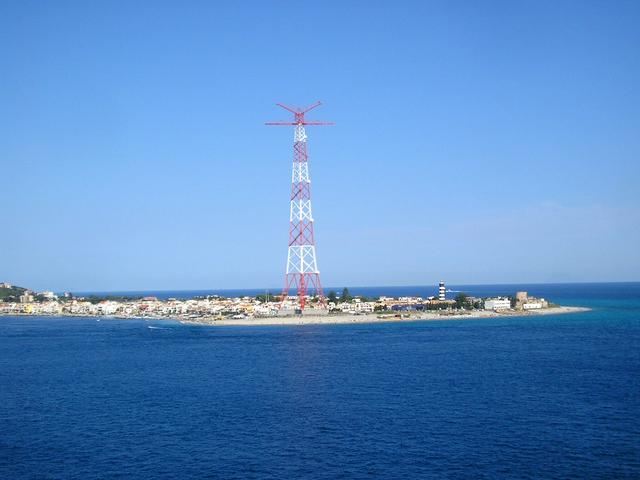
- Orto Botanico, Piazza XX Settembre, +39 090 391940. M-F 8:00-12:00. Admission free.
- Teatro Vittorio Emanuele II, Via G. Garibaldi.
- Pilone di Torre Faro. It's one of two Piloni dello Stretto, decommissioned electricity pylons across Messina Strait. They were built in 1957 to support 220kV power line over the Strait of Messina. It is a 224 metres tall steel lattice tower, which is today an observation tower with an observation platform 200 metres high. Unfortunately you have to walk 1250 steps up and down, but the great view on the huge structure and the good view over Messina Strait is surely worth it! And while you're in Torre Faro, might as well visit the nearby active Capo Peloro lighthouse.
- Lakes of Ganzirri and Faro, at the Capo Peloro Lighthouse area north of the city, in the north-eastern tip of Sicily. You can reach the two lakes by taking bus number 79 from ATM bus terminal (Parcheggio Cavallotti) close to the train station. At the lakes, the extraordinary marine landscapes are an awe-inspiring sight. It is also the site for the northern tower of the planned, twice-approved and twice-cancelled, Strait of Messina bridge (which locals hope will never be built) and the decommissioned Pylon of Torre Faro (see below). Moreover, the lakes are the right place to have very good fish, seafood, and many other Sicilian specialties.
Orto Botanico, Piazza XX Settembre, +39 090 391940. M-F 8:00-12:00. Admission free.
Teatro Vittorio Emanuele II, Via G. Garibaldi.
Pilone di Torre Faro. It's one of two Piloni dello Stretto, decommissioned electricity pylons across Messina Strait. They were built in 1957 to support 220kV power line over the Strait of Messina. It is a 224 metres tall steel lattice tower, which is today an observation tower with an observation platform 200 metres high. Unfortunately you have to walk 1250 steps up and down, but the great view on the huge structure and the good view over Messina Strait is surely worth it! And while you're in Torre Faro, might as well visit the nearby active Capo Peloro lighthouse.
Lakes of Ganzirri and Faro, at the Capo Peloro Lighthouse area north of the city, in the north-eastern tip of Sicily. You can reach the two lakes by taking bus number 79 from ATM bus terminal (Parcheggio Cavallotti) close to the train station. At the lakes, the extraordinary marine landscapes are an awe-inspiring sight. It is also the site for the northern tower of the planned, twice-approved and twice-cancelled, Strait of Messina bridge (which locals hope will never be built) and the decommissioned Pylon of Torre Faro (see below). Moreover, the lakes are the right place to have very good fish, seafood, and many other Sicilian specialties.
- Al Gattopardo, Via Santa Cecilia, 184, +39 090 673 076. Tu-Su lunch 12:00-15:00, dinner 19:00-00:00. Med cuisine.
- Pizza Napoletana, 42 Via Cannizzaro. Central pizzeria.
Al Gattopardo, Via Santa Cecilia, 184, +39 090 673 076. Tu-Su lunch 12:00-15:00, dinner 19:00-00:00. Med cuisine.
Pizza Napoletana, 42 Via Cannizzaro. Central pizzeria.
- Dockers, 31 Via Vittorio Emanuele, +39 366 488 6865. Daily 06:30-14:30. Bar, grill & Irish pub.
Dockers, 31 Via Vittorio Emanuele, +39 366 488 6865. Daily 06:30-14:30. Bar, grill & Irish pub.
- Novara di Sicilia - Located in the province of Messina on the northern side of Mt. Etna, this picturesque medieval town is nestled in the mountains overlooking Milazzo. It is the archetype of a typical medieval town, with its friendly and accommodating people who speak a distinctive dialect.
- The main public transport routes are west to Milazzo and Palermo, south to Taormina, Catania and Syracuse, or east across the straits to mainland Italy.
Novara di Sicilia - Located in the province of Messina on the northern side of Mt. Etna, this picturesque medieval town is nestled in the mountains overlooking Milazzo. It is the archetype of a typical medieval town, with its friendly and accommodating people who speak a distinctive dialect.
